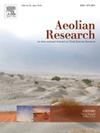Lagging behind: Impact of non-native gravel within a coastal dune system
IF 3.4
3区 地球科学
Q2 GEOGRAPHY, PHYSICAL
引用次数: 0
Abstract
Recent research has increasingly focused on the intricate relationship between wind dynamics and sediment transport in coastal settings, particularly how surface features affect aeolian transport processes. Non-erodible roughness elements such as gravel or shell deposits play a significant role by altering wind flow and raising the wind velocity threshold required to mobilize sediment. Despite advancements in modeling, fully understanding sediment transport dynamics remains challenging due to the complex interactions between surface features and wind dynamics. This study explores the influence of non-erodible lag surfaces on sediment transport in sandy barrier island environments. Fieldwork on Santa Rosa Island, Florida, involved two plots: one with a natural sandy surface and another with a gravel lag surface. Wind and sediment transport were monitored for three months using cup anemometers and Wenglor particle counters. Spline regression models identified a two-knot system at wind speed thresholds of 9 ms−1 and 11 ms−1, representing critical changes in sediment transport dynamics. Our results show that non-erodible surfaces significantly reduce sediment transport at lower wind speeds. At wind speeds below 9 ms−1, sediment transport on the lag surface was 131 percent lower than on the non-lag surface. However, as wind speeds increased, the influence of the lag surface diminished, and no significant difference in transport was observed at wind speeds above 11 ms−1. These findings emphasize the intricate role of non-erodible elements in reducing sediment transport at lower wind speeds while enhancing transport dynamics under stronger wind conditions. These insights inform future models and guide coastal management practices.
落后:海岸沙丘系统中非原生砾石的影响
最近的研究越来越多地集中在沿海环境中风动力和沉积物输运之间的复杂关系,特别是地表特征如何影响风成过程。不可侵蚀的粗糙元素,如砾石或贝壳沉积物,通过改变风向和提高调动沉积物所需的风速阈值发挥重要作用。尽管在建模方面取得了进步,但由于地表特征和风动力之间复杂的相互作用,完全理解沉积物的输运动力学仍然具有挑战性。本研究探讨了沙障岛环境中不可侵蚀滞后面对泥沙输运的影响。在佛罗里达州圣罗莎岛的实地考察涉及两个地块:一个是天然沙质表面,另一个是砾石滞后表面。利用杯状风速计和Wenglor粒子计数器对风和泥沙输运进行了三个月的监测。样条回归模型确定了风速阈值为9 ms−1和11 ms−1时的双结系统,代表了泥沙输运动力学的关键变化。我们的研究结果表明,在较低风速下,不可侵蚀表面显著减少了沉积物的输运。风速低于9 ms−1时,滞后面输沙量比非滞后面低131%。然而,随着风速的增加,滞后面的影响减弱,在11 ms−1以上的风速下,输运没有显著差异。这些发现强调了非可蚀性元素在低风速下减少沉积物输运而在强风条件下增强输运动力学中的复杂作用。这些见解为未来的模式提供了信息,并指导了沿海管理实践。
本文章由计算机程序翻译,如有差异,请以英文原文为准。
求助全文
约1分钟内获得全文
求助全文
来源期刊

Aeolian Research
GEOGRAPHY, PHYSICAL-
CiteScore
7.10
自引率
6.10%
发文量
43
审稿时长
>12 weeks
期刊介绍:
The scope of Aeolian Research includes the following topics:
• Fundamental Aeolian processes, including sand and dust entrainment, transport and deposition of sediment
• Modeling and field studies of Aeolian processes
• Instrumentation/measurement in the field and lab
• Practical applications including environmental impacts and erosion control
• Aeolian landforms, geomorphology and paleoenvironments
• Dust-atmosphere/cloud interactions.
 求助内容:
求助内容: 应助结果提醒方式:
应助结果提醒方式:


